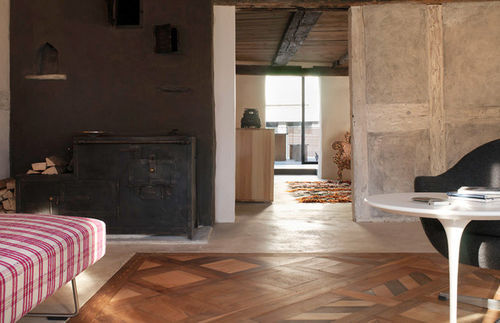Beautiful Externals
"no ideas but in things"
Monday, May 20, 2013
Sunday, March 31, 2013
Monday, March 25, 2013
Saturday, February 23, 2013
Friday, January 18, 2013
Tuesday, May 1, 2012
Wednesday, March 21, 2012
Tuesday, March 20, 2012
Bactrian Camel



The Bactrian Camel is one of two surviving species of camel. In the wild, they are critically endangered, with just 800 camels roaming around in small areas of central Asia. There about 1.4 million of them in captivity. The captive camels behave differently to the wild camels and even have their own subspecies classification.
A Long History of Domestication
The Dromedary Camel has one hump, while the Bactrian Camel has two humps. The humps are used for the storing of fat. The huge fatty deposits retain water, enabling the camel to survive for long periods without access to water.
The Bactrian Camel was domesticated approximately 4,500 years ago, in the region of northern Iran or Northeast Afghanistan. The name comes from the historical region Bactria. One of the big differences between wild Bactrians and captive camels, is the wild camels will drink salty water, from the sea or salt flats. Tame camels do not exhibit this behavior, probably due to humans supplying them with water periodically. And when they start to drink, they get serious, drinking up to 30 gallons in a couple minutes.
Designed to Withstand Heat
If you had to design an animal that could survive desert conditions, you cannot get much better than the Bactrian Camel. They are able to withstand extreme temperature fluctuations, between -40 degrees Fahrenheit (-40 °C) and 100 degrees Fahrenheit (40 °C).
They are able to eat and digest almost any vegetation they find in desert and semi-desert environments and can happily drink non-potable water. They are fairly large, measuring 2.5m (8.2 feet) to 4m (13 feet) from head to toe, and are equally tall as they are long, from head to ground.
They are strong too, weighing between 300kg (660 lb) and 700kg (1540 lb), they can carry a couple of hundred kilograms of cargo over a distance of 50km (31 miles) per day.
In the wild, they live alone, or in groups of around 30 members. The groups have a single adult make leader. It is best not to mess with this dominant male because he will bite, spit or sit on any male who challenges him.
Bactrian Camels can move both legs on one side of their bodies simultaneously – something few other mammals are capable of. Pregnancy lasts just over a year, on average, and female camels give birth to a single foal that weighs a massive 37kg (81 lb)! They take five years to reach maturity and live for up to 50 years.
Friday, March 16, 2012
Las Hilanderas, Diego Velázquez

Las Hilanderas is a painting by the Spanish painter Diego Velázquez, dating from c. 1657 and housed in the Museo del Prado of Madrid, Spain. It was painted for Don Pedro de Arce, huntsman to King Philip IV[1]. Stylistic elements, such as the lightness, the economical use of paint, and the clear influence of the Italian Baroque, have led many scholars to assert that it was painted in 1657. Others place it earlier, at some time between 1644-50, perhaps because certain aspects of its form and content recall the bodegones Velázquez painted in his early career.
The second ambiguity concerns the subject matter. Traditionally, it was believed that the painting depicted women workers in the tapestry workshop of Santa Isabel. In 1948, however, Diego Angula observed that the iconography suggested Ovid's Fable of Arachne, the story of the mortal Arachne who dared to challenge the goddess Athena to a weaving competition and, on winning the contest, was turned into a spider by the jealous goddess. This is now generally accepted as the correct interpretation of the painting.
In Las Hilanderas, Velázquez developed a layered composition, an approach he had often used in his earlier bodegones, such as the Kitchen Scene with Christ in the House of Martha and Mary. In the foreground is the contest. The goddess Athena, disguised as an old woman, is on the left and Arachne, in a white top facing away from the viewer, is on the right. Three helpers assist them. In the background, a raised platform (perhaps a stage) displays the finished tapestries. The one visible to us is Arachne's, showing The Rape of Europa — another Greek myth. This is in fact a copy of Titian's version of the subject, which was in the Spanish royal collection.
The painting has been interpreted as an allegory of the arts and even as a commentary on the range of creative endeavor, with the fine arts represented by the goddess and the crafts represented by Arachne. Others think that Velázquez' message was simply that to create great works of art, both great creativity and hard technical work are required. Other scholars have read political allegories into the work.
Monday, March 5, 2012
Monday, February 27, 2012
Friday, February 24, 2012
http://upload.wikimedia.org/wikipedia/commons/2/21/Saint_Hieronymus_%28follower_of_Joos_van_Cleve%29.jpg
https://www.google.com/search?client=ubuntu&channel=fs&q=Saint%20Hyeronimus&oe=utf-8&um=1&ie=UTF-8&hl=en&tbm=isch&source=og&sa=N&tab=wi&ei=NVpIT9yhBcPv0gGtu5CeDg&biw=1280&bih=712&sei=O1pIT-O5C8WrgweG0rSaDg#um=1&hl=en&client=ubuntu&channel=fs&tbm=isch&sa=X&ei=O1pIT92SFYqjgwfy-uWBDg&ved=0CEEQvwUoAQ&q=Saint+Hieronymus&spell=1&bav=on.2,or.r_gc.r_pw.r_qf.,cf.osb&fp=8dab8dcfabcf1521&biw=1280&bih=712
https://www.google.com/search?client=ubuntu&channel=fs&q=Saint%20Hyeronimus&oe=utf-8&um=1&ie=UTF-8&hl=en&tbm=isch&source=og&sa=N&tab=wi&ei=NVpIT9yhBcPv0gGtu5CeDg&biw=1280&bih=712&sei=O1pIT-O5C8WrgweG0rSaDg#um=1&hl=en&client=ubuntu&channel=fs&tbm=isch&sa=X&ei=O1pIT92SFYqjgwfy-uWBDg&ved=0CEEQvwUoAQ&q=Saint+Hieronymus&spell=1&bav=on.2,or.r_gc.r_pw.r_qf.,cf.osb&fp=8dab8dcfabcf1521&biw=1280&bih=712
Sunday, February 19, 2012
Durer points to his pain, send the image to his doctor

Sometime around the year 1512 Albrecht Dùrer was feeling unwell. In order to describe his ailment to a physician, who was presumably not in the vicinity of his actual body, he created this image of himself locating the pain in his left side between his thoracic and abdominal regions.
Albrecht Dürer (1471-1528), the illustrious German printmaker, painter, and designer, produced an intriguing pen and watercolour, half length self portrait. The Sick Dürer is small, 12 cm×11 cm, and on it Dürer wrote, “Do wo der gelb fleck is und mit dem finger drawff dewt do is mir we” (There, where the yellow spot is located, and where I point my finger, there it hurts”). Why Dürer used colour remains a mystery, but it could have been added for emphasis, just as his index finger draws attention to the painful part.
The picture was sent to an out of town physician whom Dürer had consulted. When it was painted is uncertain, and suggested dates range from 1509 to 1521.3 Dürer had been unwell on several occasions during this period, but it seems most likely that the picture relates to the illness he contracted in 1520. In the spring of 1521 Dürer recorded in his diary that, during a journey to the Netherlands the previous year, he had been seriously ill: “In the third week after Easter I was seized by a hot fever, great weakness, nausea, and headache. And before, when I was in Zeeland, a strange sickness came over me, such as I have never heard of from any man, and I still have this sickness.”
Sunday, February 12, 2012
Clemente Susini, Wax Anatomical Displays
Beautiful Externals: Clemente Susini, Wax Anatomical Displays: http://www.flickr.com/photos/astropop/2416846549/
Friday, February 10, 2012
Medieval Bookshelf
Sunday, January 29, 2012
Saturday, January 28, 2012
Subscribe to:
Posts (Atom)


.jpg)









































